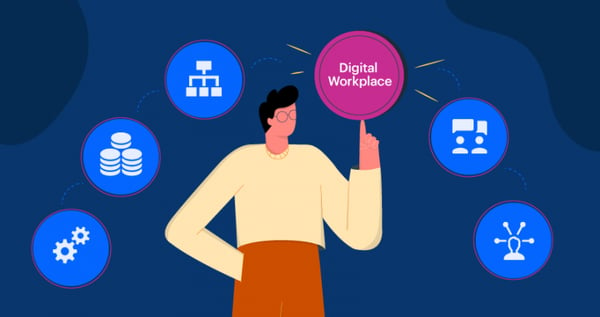September 16, 2020
 by Suresh Sambandam / September 16, 2020
by Suresh Sambandam / September 16, 2020

Until recently, the word “workplace” evoked images of desks, computers, phones, conference rooms, and managers who checked in at workstations to see what employees were doing.
Now, a fast-moving global digital transformation has allowed workplaces to evolve to where many companies exist and work entirely on the cloud. How did we get here? And what made it possible?
The rapid evolution of technology has allowed us to make giant strides in the way we communicate, collaborate, and execute work. What began as emails, video conferencing, file sharing, and other technological innovations has grown into entire ecosystems of digital applications, tools, and services that allow workforces spread across the globe to connect and work together in real-time.
But does this mean we have arrived in the era of the digital workplace? Think again.
With huge advancements in technology, software, connectivity, and artificial intelligence, the digital workplace has been on an epic journey of progression through the last decade. While it’s evident that we’re at a great place right now in terms of cutting-edge digital workplace platforms, we’ve barely scratched the surface of the potential they offer.
With all the variables, innovation and futuristic technologies in development right now, it seems far-fetched to attempt to roll the idea of the digital workplace into a single definition. But this one comes close enough: “A digital workplace is a platform where employees can collaborate and manage multiple types of work regardless of their location as they embrace a digital culture.”

In other words, the ideal digital workplace isn’t merely an amalgamation of digital tools and technologies that moves all your work to the virtual space. It helps if you envision a digital workplace as a living, breathing virtual entity that is entirely in sync with the work requirements of your business, your employees, your customers, vendors, and everyone or everything your organization engages with.
While we have a long way to go in terms of current workplace technology and tools, almost every business around the world has started this journey. There are a vast number of tools and applications available right now that give organizations of all sizes a large degree of flexibility for virtual and remote work. Many of those tools might even lay claim to technological superiority in specific areas of virtual work such as collaboration, process, and project management.
However, most of these tools are just what they describe themselves as. They are a means to execute work virtually and are not a digital workplace by themselves. Some leading platforms come close to being an all-round digital workplace, but we’ve still got a long way to go in terms of integrating all aspects of work into a single digital platform that can be called the ideal digital workplace. The good news is, we’re almost there.
Advances in communication technologies and positive lifestyle trends over the past decade have created a global workforce that is more productive and capable than ever before. With work cultures across the world turning more technology intensive and independently driven, a phased shift to the digital workplace was already slated to happen soon. However, recent developments have accelerated the worldwide shift to digital work.
With a phenomenal rise in the number of businesses and companies that have switched to remote work, a digital workplace platform is desperately needed. The always-connected digital environment of today leaves little room to continue justifying traditional workplaces. Physical offices, though essential in some cases, are largely turning into expensive relics of the past.
When employees can login from anywhere in the world on their own devices with unfettered single-window access to their work, their colleagues and all the data and tools they will need, they can accomplish work at much higher levels of productivity than they would otherwise.
This is the single most important reason why the digital workplace is the future of work spaces worldwide. If you’re looking for a technological metaphor, this transition is as unstoppable as the switch from wired to wireless networks. Wired networks didn’t necessarily disappear, but wireless has irreversibly taken over our lives.
However, the argument in favor of the digital workplace should really revolve around the adaptability it brings to any business. Imagine if you could wrap up your entire office, relocate it, spread it across locations, close it entirely or shuffle departments across continents.
Would you still expect your employees to continue performing at the same levels of productivity as they did before? With a digital workplace, the answer to that question is a resounding yes. In a fast-changing world where global paradigms shift in mere months, switching to a digital workplace ensures business adaptability, sustainability, performance and productivity.
Many organizations assume that a collection of various digital work tools that help employees collaborate online means they have some form of digital workplace up and running. However, that is like assuming you’re looking at a house because you see a yard full of bricks, mortar, and steel.
It is also a common mistake to assume that tools of collaboration meant to help employees communicate can somehow be termed digital workplaces. However, if you’re looking for a great digital workplace platform that manages to bring it all together, here’s a list of must haves.
A good digital workplace platform contains all the technologies and tools employees will need to get work done. However, the idea of the digital workplace isn’t just restricted to its digital aspect. Technology is only as good as the people who use it. Therefore, a digital culture developed in tandem with a digital transformation is what leads an organization toward creating a truly digital workplace.
The ideal digital workplace allows people to:
Right off the bat, a digital transformation and the switch to a digital workplace offers any organization a vast set of advantages. There are many benefits that show up across multiple sectors as you begin your shift to a digital workplace and embrace a digital culture.
As a transformation that makes work more efficient and easier, you will find that you attract better talent that doesn’t look to migrate elsewhere. You can watch productivity rise as happiness levels continue to grow within the organization. People will be more in tune with their work and collaborate more efficiently with their teams to deliver their best work with minimal oversight.
Vast numbers of organizations worldwide are making the transition to a digital workplace in some way or the other. While many are in the early stages of this transformation, some have almost covered the entire journey. However, what matters most is that the global shift to the digital workplace has accelerated at a never-before-seen pace and this is bringing along with it the many advantages we have outlined.
At this nascent stage, it is important for organizations to invest resources into developing a digital culture among their employees while also picking a digital workplace platform that can provide the best experience in this transition to the future of work. Here’s a great list of the advantages of moving to a digital workplace platform.
In the rush to digital transformations, most organizations forget the one key aspect that can define the success of their push towards a digital workplace. It is the culture within which it is encapsulated.
“Transformations aren’t about technology, they’re about people. And when those people aren’t aligned with the transformation that surrounds them, it becomes that much harder to access the benefits of technologies and platforms aimed at liberating them from the status quo. This is why digital transformations must always begin with the people that will drive them. Build the foundations of your digital workplace with your people and the platforms you pick or build will be unstoppable well into the future.”
Every organization has its own unique work culture. That is why there is no one-size-fits-all solution to this aspect of a digital workplace.
It is also a pickle that most digital transformation shepherds quickly find themselves in as they chart a transition to a digital workplace. While absolutely necessary to ensure the success of a digital workplace, organizations have to decide for themselves as to the kind of digital culture they want to build based on their own needs.
However, an ideal digital culture mandates a few things. Seamless contextual collaboration, unfettered two-way communication and a wholesome sense of community in getting work done are some of the most important things you will need to look out for when you outline the change management required to herald a digital culture at your organization.
In comparison to all the topics we have discussed yet, this one is fairly simple. Let’s assume you have set a digital transformation in motion and have primed your workforce to begin adopting a digital culture. It now boils down to the platform you will choose to begin your switch to a wholly digital workplace.
Imagine you’re picking out an office space for your business. What are the important things you should look out for? Great connectivity, workstation adaptability, well-equipped conference rooms, leisure spaces, aesthetically pleasing architecture? The list may go on.
Now, if your business needs are fairly run-of-the-mill, you can rent or lease an office space that you think fits your needs. If your requirements are much more niche or vast and your budgets are fairly high, you could opt to build your own custom office building. Either way, it pays to remember that you’re making a choice that has to fit your business needs for a while to come.

Choosing a digital workplace platform is similar because once you pick one, you’re stuck with it for a while unless you want to stare at another costly transition. That is why it makes a lot of sense to decide what you need and research the scope of the platforms you’re reviewing to assess how well they will hold out a few years down the road.
Broadly, there are two ways to pick a digital workplace platform:
The former is hugely expensive, prone to cost overruns, requires an enormous investment of resources and is only really justified if your business operates on a scale or in a niche that really requires a bespoke digital workplace platform.
On the other hand, there are great digital workplace platforms out there designed by companies that specialize in the field. Some of these platforms are low-cost, feature-rich, turn-key solutions that come with elaborate support. They’ve also got the technical background and experience of having worked with various businesses around the world.
Of these, there are a select few that stand out as great digital workplace platforms supported by positive reviews, industry recognition and testimonials from businesses that use them. Shortlisting from these would be a great starting point in your quest for the digital workplace platform that will take your business into the future.
Now that we’ve seen what a digital workplace is and having gone through all the elements that help build one, it is important to reiterate that a platform by itself doesn’t constitute a digital workplace. The ideal digital workplace is an idea that involves a constellation of many things.
It is a place where technology, tools, applications and people unite as a single entity to contextually collaborate and deliver the kind of productivity the future will demand. It is a place where work happens, effortlessly, efficiently and productively with minimal physical presence or interference.
Suresh Sambandam is the CEO of Kissflow. He’s an expert and renowned entrepreneur on a mission to democratize cutting-edge technologies and help enterprises seamlessly orchestrate their work through an intuitive blend of collaboration, coordination and control. He also co-founded SaaSBoomi, Asia’s largest SaaS Conference.
Remember HAL 9000 from "2001: A Space Odyssey"? The eerily calm, near-sentient robot? It was a...
 by Sidharth Yadav
by Sidharth Yadav
Feeling overwhelmed by the ever-changing HR landscape?
 by Sadaf Tanzeem
by Sadaf Tanzeem
In today’s remote-first world, businesses face challenges like securing desktop access,...
 by Sagar Joshi
by Sagar Joshi
Remember HAL 9000 from "2001: A Space Odyssey"? The eerily calm, near-sentient robot? It was a...
 by Sidharth Yadav
by Sidharth Yadav
Feeling overwhelmed by the ever-changing HR landscape?
 by Sadaf Tanzeem
by Sadaf Tanzeem


